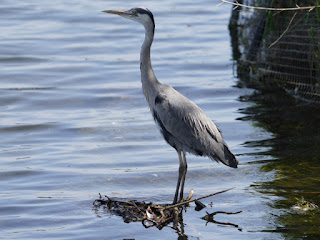The solitary Egyptian gosling on the Long Water ate some algae.
The broods of ten ...
... and six are still all right.
A Coot has built a nest on the deserted platform of Bluebird Boats. This is not a good place, since when the chicks fall into the water they won't be able to get up again. Last year when this happened Mateusz made a wooden ramp for them, but it never occurred to them to use it.
A top view of the big nest at the Dell restaurant, showing how much substructure is necessary to get it above water level in a depth of about 2ft 6in. Heaven knows how the Coots moved those big waterlogged branches.
The single Coot chick on the Long Water is quite big now. It would probably survive if its parents decided to nest again.
A Coot nest makes an ideal fishing platform for a Grey Heron, which is tough on the Coot.
The Little Owl near the Henry Moore sculpture was in her favourite alder tree.
The Blue Tits' nest in the lamp post on the south edge of Hyde Park was a busy scene.
But apart from that not much was happening, so I got on my bike and trundled off to the Leg o' Mutton reservoir between Hammersmith Bridge and Barnes to see if any Common Terns had arrived to nest on the rafts.
They hadn't, and the rafts were variously occupied by a pair of Black-Headed Gulls and a Pochard ...
... a Mute Swan whose weight made the raft list ...
... Some Greylag Geese, and a terrapin, probably a Red-Eared Slider such as we have in the park.
More pictures from elsewhere: Joan Chatterley went to St James's Park to check on the two cygnets ...
... and to Battersea Park to see the blonde Egyptian gosling, now growing fast.
Duncan Campbell asked an interesting question: why is it that you don't see dandelion seed heads half open? I suggested that they opened very quickly. So he did an experiment with a withered dandelion in a bottle of water. These pictures are taken at half-hour intervals, so it took two hours before the seed head was mostly open, after which (not shown) it filled out more slowly. So the question is still open. The process might happen a bit quicker on a live dandelion, of course.


















I have seen them half open occasionally, on a live plant. Didn't stick around to time further opening , though. Maybe we don't look at them often enough.
ReplyDeleteTrue. Dandelion watching might be as subtle as water watching in The Man in the High Castle (which would be forbidden now because of its carbon footprint).
DeleteI'm down for Dandelion watching, the exact same time we regain our freedom.
DeleteVery, very glad to see so many babies. I hope this year more of them will grow up to become teenagers.
Black-Headed Gulls are looking so smart!
Freedom? As they say in Egypt, Bukra fil mishmish, 'Tomorrow, in the time of the apricots.'
DeleteIt's odd. In the park we lose all our Black-Headed Gulls in April as they fly to their breeding grounds, and here is a breeding ground 20 minutes away by bicycle.